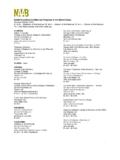Transcription of IV. School of Architecture and Planning
1 School of Architecture and Planning 2016-17 Graduate Announcements - The Catholic University of America IV. School of Architecture and Planning Officers of Instruction Faculty Randall Ott, , AIA Dean, Professor Judith Meany, , FAICP Associate Dean for Academic Affairs, Clinical Associate Professor Hollee Becker, Associate Dean for Student Affairs, Associate Professor Patricia Andrasik, , AIA, IIDA, LEED AP Assistant Professor Julio Bermudez, Associate Professor Luis Eduardo Boza, Associate Professor Ann Cederna, ,AIA Professor Lavinia Fici Pasquina, , RA (Italy) Associate Professor Christopher P. Grech, , RIBA Associate Professor Vytenis Gureckas, , RA Associate Professor Miriam Gusevich, Associate Professor G. Bradley Guy, MSAS Director MCRP/MSSD Program, Assistant Professor Charles Hostovsky, Assistant Professor Eric J. Jenkins, , , AIA Professor J. Ronald Kabriel, Assistant Professor Julius S. Levine, , , FAICP Professor Adnan Morshed, Associate Professor Stanley I.
2 Hallet, , FAIA Professor Emeritus Theodore Naos, Professor Emeritus Walter D. Ramberg, , AIA Professor Emeritus John V. Yanik, , AIA Professor Emeritus Associates of the Faculty Mark McInturff, , FAIA Lecturer Iris Miller, , ASLA Lecturer Travis L. Price III, , FAIA Lecturer David Shove-Brown, , AIA Lecturer Rafael Vargas, Lecturer Timothy Bertschinger Lecturer Fernando Iribarren Lecturer William Bonstra Lecturer School of Architecture and Planning 2016-17 Graduate Announcements - The Catholic University of America Jui-Chen (Roger) Chang Lecturer George Dove, Lecturer Karl DuPuy Lecturer Hussan Elkhrraz, Lecturer Eric Liebmann Lecturer Paul Totten, (MD, VA), LEED AP Lecturer Mission CUA's School of Architecture and Planning attracts students from throughout the United States and the world who are aware of the School 's long history and educational renown. The professional Architecture program at CUA was established in 1911, and after nine decades its reputation is expressed in a continuing legacy of design excellence-early Beaux Arts prizewinners to contemporary AIA award-winning faculty work and student projects.
3 In CUA's School of Architecture and Planning , students are exposed to the foundational and the conventional, as well as to the experimental and unorthodox. Diverse theoretical perspectives, paradigms, project types from varied architects landscape architects, urban designers and planners become key elements in our various teaching/learning activities. Our full-time faculty, along with a distinguished array of adjuncts and visiting lecturers and studio critics drawn from the profession, provide our students with an excellent, stimulating context within which they pursue their learning. Goals Historically, the profession of Architecture has placed the highest priority on the artful creation of place, incorporating the great Roman architect/engineer Vitruvius' three principles of firmness, commodity and delight. Consequently, the architect must be well versed in the arts, technically skilled, and possess a deep understanding of the human condition. Thus, the School seeks to impart a proper sense of ethics and a spirit of service to the community.
4 The emphasis on these qualities gives professional training its distinctive character at The Catholic University of America. The School of Architecture and Planning is dedicated to the professional education of those who will design, build and conserve the built environment, principally as architects and planners. Utilizing Washington and other metropolitan areas as design laboratories, the graduate program provides an enriching educational climate in which students investigate the realms of design, theory and building in the context of the world in which we live. Students are exposed to a diversity of architectural experiences through a choice of graduate concentrations that include Cultural Studies/Sacred Space, Design Technologies, Digital Media, Real Estate Development, and Urban Design. Central to the graduate program is the design studio, where students pursue their architectural inquiries individually or in teams. Design studios are directed by faculty members who have extensive experience in both practice and teaching.
5 Visiting critics whose professional experience is relevant to the studio projects are brought into the School to provide richness and diversity to the students' design education. The studio experience culminates in a design thesis. Supporting the studio experience are advanced courses in Architecture , Planning and related fields. Lectures, seminars and exhibitions are devised to introduce the student to the multitude of considerations faced by the practicing architect to reveal differing philosophies and attitudes toward architectural design. As in the studios, lecturers are invited from among the many outstanding professionals practicing in the Washington area to provide informal talks on their current work, teach or add their particular insights to the core courses. Degree Programs The Professional Degree CUA offers several options for earning the Master of Architecture professional degree. The two-year program is intended for students with a four-year undergraduate pre-professional degree in Architecture .
6 Select students graduating from CUA with a four-year Bachelor of Science in Architecture may be eligible for advanced standing, thereby reducing graduate study from four semesters to three semesters. The three-year program is intended for students who hold an undergraduate degree in a field other than Architecture . These Master of Architecture degree programs are fully accredited by the National Architectural Accrediting Board. The Post-Professional Degree Program The Master of Architectural Studies is offered to applicants who already hold a professional degree in Architecture and wish to pursue further investigations in design or design-related topics. Students are offered an intensive curriculum in one of five areas of concentration: Cultural Studies/Sacred Space, Design Technologies, Digital Media, Real Estate Development, and Urban Design. The program requires a minimum of one-and-a-half years of advanced study tailored to the needs and interests of the individual. Accreditation In the United States, most state registration boards require a degree from an accredited professional degree program as a School of Architecture and Planning 2016-17 Graduate Announcements - The Catholic University of America prerequisite for licensure.
7 The National Architectural Accrediting Board, NAAB, which is the sole agency authorized to accredit professional degree programs in Architecture , recognizes three types of degrees: the Bachelor of Architecture , the Master of Architecture , and the Doctor of Architecture . A program may be granted a 6-year, 3-year, or 2-year term of accreditation, depending on the extent of its conformance with established educational standards. Master's degree programs may consist of a pre-professional undergraduate degree and a professional graduate degree that, when earned sequentially, constitute an accredited professional education. However, the pre-professional degree is not, by itself, recognized as an accredited degree. Location CUA's location in Washington, , puts students in touch with unparalleled professional and cultural resources. Its spacious campus lies within a 10- minute drive of the Capitol and the National Mall. Numerous national and international experts live and work in the vibrant and diverse metropolitan area and contribute to the graduate program each academic year.
8 The specialized expertise of these associates of the faculty allows the School to offer an outstanding array of graduate coursework. The School has had relationships with numerous Washington, , cultural and artistic institutions, including the National Building Museum, the Library of Congress and others. In addition, the School 's location offers it unparalleled access to many national chapter headquarters of various design-oriented organizations, such as The American Institute of Architects, AIA, the Association of Collegiate Schools of Architecture , ACSA, the National Architectural Accrediting Board, NAAB and the American Institute of Architecture Students, AIAS. The School has also over the last several years maintained a relationship with various embassies in the region, sponsoring cooperative lecture and exhibit programs with the Finnish embassy, the Swiss embassy, the Austrian embassy and others. Faculty and Resources Many of our faculty members are recognized as leaders in the design and professional realms with world-famous guest critics and lecturers augmenting the full-time teaching staff.
9 Student-to-professor ratios are kept small to ensure that students receive intensive one-on-one critiques and advising from studio critics and professors. Our award-winning facilities are housed in the original CUA gymnasium and provide a classic example of adaptive re-use at its best. Designed by a faculty member, the Architecture center was conceived as a small city with "streets" filled with students and their work, a "piazza" for special exhibits and a "town hall" for lectures and meetings. In addition, students' needs are served by our library CAD lab and output room, visual resource center and fabrication lab, which includes wood and metalworking shops, two CO2 laser cutter and engraving systems, a 3D printer and a three-axis CNC milling machine. Through the Consortium of Universities of the Washington Metropolitan Area, students may earn credits from among the several other institutions of higher learning in the community. Concentrations The School of Architecture and Planning currently offers five areas of concentration available to students for more focused specialization during their graduate education.
10 These are Cultural Studies/Sacred Space, Design Technologies, Digital Media, Real Estate Development, and Urban Practice. Cultural Studies/Sacred Space The pursuit of cultural studies and the investigation and design of sacred space is intrinsic to CUA's mission. This concentration affords students an opportunity to explore cultural studies and the related issues of settlement, geography and landscape. The studios and related seminars explore a variety of historic case studies, theoretical positions and architectural strategies that have been or can be taken when architects are obliged to intervene in arenas of great cultural context and, in particular, in the re-articulation of sacred space. The dilemma of relating the exigencies of our "time" to the traditional forms and rituals of the past are only further complicated by a situation where once identifiable cultural groups have now been thrown into disjunction, discontinuity and disarray. Thus, the often irreconcilable debate between "natural state" and chaos, between nostalgia for the past and the "crisis of modernity," between critical regionalism and international style, become but a few of the issues the concentration examines.



